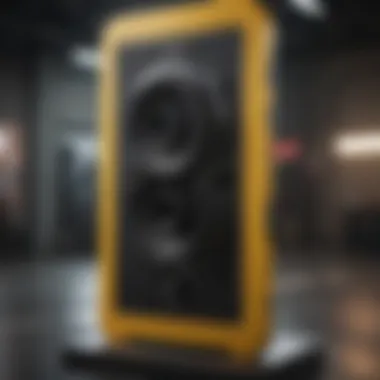Understanding Fiberglass Boards: Materials and Innovations


Intro
Fiberglass boards are increasingly popular in extreme sports. Their unique properties, such as durability and lightweight structure, make them prime choices for activities like surfing, snowboarding, and skateboarding. As extreme sports continue to evolve, so does the technology behind fiberglass boards, leading to enhanced performance and safety.
Understanding the materials used, their applications, and innovations around fiberglass boards is essential for both novice enthusiasts and professional athletes. This knowledge not only helps athletes choose the right equipment but also allows them to stay informed about trends that could affect their performance and safety.
In this article, we explore the multifaceted world of fiberglass boards. By examining their materials, uses, and emerging innovations, we aim to arm athletes with the insights they need to optimize their extreme sports experiences.
Intro to Fiberglass Boards
Fiberglass boards have made a significant impact in the realms of sports and recreation. Understanding fiberglass boards is key for both novice and experienced athletes who wish to engage in extreme sports. These boards are designed with versatility and performance in mind, addressing the needs of users in challenging environments.
The importance of fiberglass boards lies in their unique composition and manufacturing process. Fiberglass is a composite material made up of fine glass fibers and resin, providing a balance of strength and lightweight properties. This characteristic is crucial for athletes who need to maneuver quickly while maintaining durability against the rigors of extreme activities, from surfing to snowboarding.
Athletes should consider several elements when choosing a fiberglass board. One major aspect is the intended use. Depending on the desired sport, boards can vary significantly in design and material composition. Additionally, understanding the benefits of fiberglass, such as its resistance to water, impact durability, and ease of repair, can make a notable difference in the performance for the user.
Furthermore, as technology advances, innovations in the design and materials used in fiberglass boards continue to emerge. This evolving landscape suggests an advantage for athletes who remain informed about trends and new technologies. For instance, some newer models integrate hybrid materials that enhance performance even further.
Composition of Fiberglass Boards
Understanding the composition of fiberglass boards is crucial for anyone involved in extreme sports. This section looks at the specific elements that make up these boards and how each component contributes to their overall performance, durability, and suitability for different applications. A good grasp of materials ensures that athletes select the correct board for their specific needs, enhancing their sporting experience.
Understanding Fiberglass Materials
Fiberglass boards are primarily made from a combination of glass fibers and resin. The glass fibers provide strength and rigidity, essential for performance under various conditions, including surfing and snowboarding. These fibers are lightweight yet have high tensile strength, making them ideal for high-impact activities. The durability of fiberglass allows it to withstand extreme forces without compromising its structure.
The resin is the second critical component. It binds the glass fibers together, creating a solid, integrated structure. Resins come in different types, each with unique properties that affect the performance of fiberglass boards. Understanding the specific materials used in a board can help athletes make informed decisions.
Benefits of fiberglass materials include:
- High Strength-to-Weight Ratio: Fiberglass boards are lightweight yet robust, allowing for better maneuverability.
- Resistance to Chemical Damage: These boards are better at resisting damage from seawater and snow, extending their lifespan.
- Versatility in Design: Fiberglass can easily be molded into various shapes, optimizing performance across different sports.
Resin Types and Their Implications
The type of resin used in fiberglass boards plays a significant role in their overall performance and durability. Common types of resins include polyester, epoxy, and vinyl ester. Each has distinctive characteristics that affect various aspects of the board’s performance.
- Polyester Resin: This is the most common resin used in fiberglass boards. It is cost-effective and provides good tensile strength. However, polyester resin is less rigid than others, which can impact performance for high-end applications.
- Epoxy Resin: Known for its superior bonding strength and flexibility, epoxy resins create more resilient boards. They provide better resistance to water and UV damage, making them suitable for heavy use. However, they tend to be more expensive.
- Vinyl Ester Resin: Often used for high-performance boards, vinyl ester offers excellent resistance to water absorption. This type of resin combines the best attributes of polyester and epoxy, ensuring enhanced durability while still being lightweight.
Key Considerations when selecting a resin type include:
- Performance requirements for the board
- Cost and budget concerns
- Desired durability and resistance to environmental factors
"The composition of fiberglass boards affects not only their performance but also their longevity and usability across various extreme sports."
Manufacturing Process
The manufacturing process of fiberglass boards is a critical aspect of their quality and functionality. Understanding this process provides valuable insight into how these boards are crafted, the materials used, and the techniques that ensure their durability and performance. Knowledge of the manufacturing steps can guide extreme sports enthusiasts in choosing the right equipment.
Production Techniques
Fiberglass boards are typically produced using a few key techniques. Two popular methods are hand lay-up and vacuum bagging.
- Hand Lay-up: This traditional method involves laying fiberglass mat and resin by hand. It allows for precise control over thickness and material placement, but can be labor-intensive and time-consuming.
- Vacuum Bagging: In this technique, the fiberglass layers are placed in a mold and covered with a vacuum bag. The vacuum removes air and compresses the materials, resulting in a stronger bond between the fiberglass and resin.
Additionally, there are advancements in automation that enhance production efficiency. Machines can assist in the layering of materials and ensure consistency in thickness and density. Automated processes can also reduce human error, which might lead to defects in the final product.


These techniques not only impact the structural integrity of the boards but also influence their weight and flexibility. Extreme athletes should consider these aspects when selecting boards tailored to their sports.
Quality Control Standards
Quality control is another vital component in the manufacturing process of fiberglass boards. Ensuring that each board meets certain standards can significantly affect its performance and lifespan.
Quality checks are usually integrated at multiple stages in production:
- Material Inspection: Raw materials like fiberglass and resin are assessed before production to guarantee they meet the required specifications.
- In-Process Monitoring: During production, parameters such as temperature, pressure, and resin application are monitored to maintain optimal conditions and avoid defects.
- Final Testing: After production, boards undergo rigorous testing to assess durability, weight, and flexibility. This could include stress tests to ensure they can withstand the demands of extreme sports.
Adhering to strict quality control measures results in more reliable and high-performing fiberglass boards. For athletes, boards that pass these standards offer assurance of performance, especially in challenging conditions.
"A well-constructed fiberglass board can make the difference between a successful run and a hazardous experience."
Overall, understanding the manufacturing process, production techniques, and quality control standards is essential for anyone interested in fiberglass boards. It allows athletes to make informed decisions, aligning their equipment with their performance goals.
Applications in Extreme Sports
The application of fiberglass boards in extreme sports holds significant relevance. Their unique properties, such as strength and flexibility, allow for enhanced performance and control in sports that require quick reactions and agility. Choosing the right board tailored to a specific sport can greatly affect outcomes, from a thrilling ride on the waves to mastering tricks on ramps. The construction of these boards not only impacts the athlete's experience but also influences the durability of the product. Below, we will explore three main areas where fiberglass boards excel: surfing, snowboarding, and skateboarding.
Surfing Boards
Fiberglass surfboards are a cornerstone of surfing culture. The combination of fiberglass and resin creates a lightweight structure that optimizes buoyancy and speed. Surfing boards come in various shapes and sizes, each designed for specific wave conditions and rider preferences. The material properties allow for intricate designs that can improve hydrodynamics, which is essential for performance in water.
Some benefits include:
- Strength: Fiberglass can withstand the harsh conditions of ocean waves.
- Customizability: Boards can be tailored to suit the skill level and style of the surfer.
Considerations when selecting a fiberglass surfboard are often based on the riding style, such as shortboard for maneuverability or longboard for stability. Athletes must evaluate their requirements carefully to ensure the board achieved complements their skill set and the surf conditions.
Snowboards
In snowboarding, fiberglass plays a vital role in the board's construction. The material is frequently layered with wood or other materials to enhance performance in different snow conditions. The stiffness of fiberglass offers riders great control over their movements, making it possible to conquer steep slopes and execute intricate tricks.
Key advantages of using fiberglass in snowboards include:
- Lightweight Nature: This enables easier handling during jumps or quick turns.
- Flexibility: Different flex patterns can be designed to cater to freestyle or all-mountain riding.
When choosing a snowboard, factors also include the board's length and width, shaping, and the rider's skill level. A well-chosen fiberglass snowboard can significantly up the ante in an athlete’s performance, ensuring they maintain agility and speed on the mountain.
Skateboards
Skateboarding boards made from fiberglass have gained popularity for their balance between resilience and weight. The lightweight property historically associated with wood is complemented by fiberglass layers to create a hybrid structure. This results in boards that endure the rigors of urban terrains and facilitate complex tricks and jumps.
Important aspects are:
- Impact Resistance: Fiberglass reduces the risk of chipping and cracking that often affects wooden boards.
- Snap and Pop: Enhanced configurations allow for improved performance during Ollies and kickflips.
In choosing a fiberglass skateboard, skaters should consider their preferred terrain, riding style, and the type of tricks they plan to perform. With the right fiberglass board, skaters can expect improved durability and style.
Fiberglass boards significantly impact the way extreme sports are enjoyed, enhancing both performance and the user experience.
In summary, the unique applications of fiberglass boards in extreme sports showcase their adaptability and pivotal role in an athlete's performance. Selecting the appropriate board based on individual needs is key to mastering each sport effectively.
Advantages of Fiberglass Boards


Fiberglass boards offer distinct advantages, making them a popular choice among extreme sports enthusiasts. The combination of resilience and performance is critical for athletes who require reliable equipment. Understanding these advantages helps users to make informed choices about their gear.
Durability and Performance
One of the most remarkable features of fiberglass boards is their exceptional durability. These boards are designed to withstand harsh environments, be it the ocean waves or rugged terrains. The fiberglass material is resistant to both water and abrasion, which translates to longer lifespan compared to other materials. The inner construction includes robust resin combined with glass fibers, making boards resilient to wear and tear.
Performance-wise, fiberglass boards deliver a balance of flexibility and stiffness. Flexibility enhances the rider's ability to maneuver easily while stiffness ensures stability during high-speed runs or turns. This combination allows athletes to perform with confidence, pushing limits without worrying about damage. The unique characteristics of these boards are essential for sports such as surfing, snowboarding, and skateboarding. They adapt well to different riding styles and conditions, which is crucial for performance-oriented users.
"The durability of fiberglass boards means less time spent on replacements and more time enjoying the sport."
Weight and Maneuverability
Another important aspect of fiberglass boards is their lightweight nature. These boards allow for better control and ease of movement. Extreme athletes, whether in surfing or skateboarding, appreciate the reduction in weight as it contributes directly to their agility. A lighter board can mean quicker response times, which is essential for tricks or rapid directional changes.
The design of fiberglass boards also plays a significant role in enhancing maneuverability. Many boards feature a contoured shape or specific tail designs to facilitate sharp turns and spins. When combined with the lightweight attribute, athletes can execute complex maneuvers more effectively. Moreover, the ability to maintain speed while making sudden adjustments is a significant advantage.
Innovations in Fiberglass Board Technology
The evolution of fiberglass board technology marks a significant chapter in the narrative of extreme sports equipment. As athletes demand higher performance levels, innovations in materials and design play a crucial role. These advancements not only enhance the durability and functionality of the boards but also influence the overall user experience. The focus on innovation reflects an industry's commitment to meet the evolving needs of both amateur and professional athletes.
Emerging Materials
In recent years, the materials used in fiberglass boards have seen substantial developments. Traditional fiberglass is often combined with other materials to create composites that offer improved performance characteristics. For instance, manufacturers are increasingly using carbon fiber and Kevlar in conjunction with fiberglass. These materials are lighter yet provide superior strength.
The emergence of bio-based resins and sustainable materials has also gained attention. These environmentally friendly options reduce the reliance on petroleum-based products while maintaining performance. This shift is essential as more consumers prioritize sustainability in their purchasing decisions. The integration of such materials not only contributes to performance but also addresses ecological concerns, making these boards more appealing to environmentally conscious athletes.
"Opting for innovative materials is not just about performance; it's about aligning athletic gear with sustainable practices."
Design Innovations
Design plays an equally important role in the advancement of fiberglass boards. Modern design techniques incorporate computer-aided design (CAD) software, allowing for precision and customization. This technology equips manufacturers to create board shapes tailored to specific types of riding—be it surfing, snowboarding, or skateboarding.
Furthermore, advances in shaping techniques have introduced variable thickness and contours which can adjust flex and responsiveness. For instance, boards with a stiffer midsection and flex in the tips can provide better maneuverability while maintaining stability. Color and graphics are also vital considerations. Athletes often seek visually appealing boards that express personal style, thereby enhancing their connection to the sport.
Customization features, such as adjustable fins in surfboards, have made waves in the market. These innovations allow users to modify their board's performance based on conditions, creating a versatile tool for athletes.
In summary, the ongoing innovations in materials and design reflect a dynamic approach to fiberglass boards. As technology and consumer preferences evolve, these advancements pave the way for heightened performance, sustainability, and personalization in extreme sports.
Environmental Considerations
The rise of extreme sports has brought significant focus on the materials and equipment used, particularly fiberglass boards. However, as the popularity of these sports grows, it is essential to scrutinize the environmental impact of these materials. Understanding the environmental considerations associated with fiberglass boards not only promotes sustainable practices but also informs athletes and manufacturers alike in making conscious choices that benefit the planet.
Sustainability of Materials
Fiberglass boards are primarily made of composite materials, combining glass fibers with resin. The sustainability of these materials is a critical aspect of their environmental impact. Some companies are exploring bio-based resins as alternatives to traditional petroleum-based epoxy resins. These bio-resins can potentially reduce carbon footprints and reliance on fossil fuels. Furthermore, sustainable glass fibers derived from recycled materials are gaining traction. This shift not only helps minimize waste but also supports a circular economy.
Using recyclable materials in the production of fiberglass boards can reduce environmental damage. Athletes may consider brands that emphasize sustainability in their product lines. This trend reflects a growing awareness in the extreme sports community regarding eco-friendly practices.
End-of-Life Options for Boards
When fiberglass boards reach the end of their life cycle, responsible disposal becomes an important concern. Unlike materials such as wood or metal, fiberglass is not biodegradable. Thus, disposal options are limited. However, increasing awareness of the environmental impact of waste is paving the way for innovative solutions.
Many manufacturers are now exploring innovative recycling methods for fiberglass. For example, companies are developing processes to break down fiberglass into reusable materials. This not only diverts waste from landfills but also contributes to the creation of new products. Additionally, athletes can consider donation programs that collect used boards for community projects or research purposes.
"The shift toward sustainability is not merely a trend; it is an essential movement for the future of extreme sports and our planet."


In summary, these aspects of environmental considerations are poised to redefine how fiberglass boards are perceived and utilized in extreme sports.
Market Trends and Insights
The landscape of fiberglass boards is continually changing, influenced by consumer demands and technological advancements. Understanding these market trends is vital for manufacturers and users alike. Awareness of these trends can help identify opportunities for innovation and improve product offerings. In this section, we will delve into two crucial components: consumer preferences and sales data.
Consumer Preferences
Consumer preferences play a significant role in shaping the fiberglass board market. As extreme sports gain popularity, users are becoming increasingly discerning about their equipment choices. Factors such as performance, durability, and aesthetics are key in their decision-making processes. Athletes often prioritize lightweight boards that provide optimal maneuverability.
Moreover, the sustainability aspect has become paramount. Many consumers now favor eco-friendly materials and production processes. They are willing to pay a premium for boards that are made from recycled materials or have a lower environmental impact.
It is also observed that social media influences consumer choices. Users often look to platforms like Instagram or Reddit for recommendations and reviews, affecting their buying habits. This increased visibility connects manufacturers with a broader audience, making it essential for brands to maintain a strong online presence.
Sales Data and Growth Projections
Analyzing sales data reveals a growing market for fiberglass boards. According to recent reports, the market is projected to grow at a consistent rate in the next few years. The surge can be attributed to the rising interest in extreme sports across various demographics, particularly among the youth.
"The demand for high-quality fiberglass boards is anticipated to rise, driven by technological innovations and a focus on performance."
Key growth areas include:
- Surfboards: Increased participation in water sports.
- Snowboards: Winter sports enthusiasts embracing new technologies.
- Skateboards: A growing culture of skateboarding in urban areas.
These segments show promising growth potential. Understanding sales data helps businesses gauge their performance relative to competitors. It also aids in making informed decisions about product development and marketing strategies.
As the market for fiberglass boards strengthens, the need for adaptive strategies becomes clear. Companies must keep an eye on emerging trends and align their product lines accordingly to meet the evolving needs of extreme athletes.
Future Directions
Exploring the future of fiberglass boards is crucial for understanding the ongoing evolution of materials and technologies. The extreme sports industry is dynamic, and so are the demands for better-performing, more sustainable fiberglass products. Not only do current trends influence production methods and material choices, but they also shape consumer expectations. As such, developments in research and innovation remain essential for both manufacturers and athletes.
Advancements in fiberglass board technology offer several benefits: addressing environmental concerns, enhancing durability, and improving performance characteristics. Moreover, keeping abreast of industry shifts enables both manufacturers and consumers to make informed decisions about their products and usage.
Research and Development Initiatives
Research and development in fiberglass technology is focused on creating lighter, stronger, and more environmentally friendly options. The current landscape emphasizes the integration of new materials like bio-resins and innovative manufacturing techniques. Such initiatives aim for a synergy between performance and sustainability, responding to a growing market segment that values eco-friendly products.
This approach is not only beneficial for the environment but may also lead to better performance on the water or slopes. Furthermore, investing in research fosters collaboration among companies, universities, and independent labs, resulting in a more robust knowledge base regarding the best practices in fiberglass manufacturing.
Potential New Applications
The potential new applications for fiberglass boards extend beyond traditional extreme sports. As materials science advances, possibilities emerge in various sectors. For instance, there is potential for using fiberglass in recreational equipment for activities like kayaking or mountain biking. Innovations in foam cores combined with fiberglass skins might yield products with exceptional resilience and agility.
Additionally, developments in composite materials could allow for customized board constructions tailored to specific athlete needs. The ability to produce bespoke boards could transform athlete performance, fitting individual styles and preferences more closely.
End
The conclusion of this article plays a crucial role in reinforcing the significance of fiberglass boards within the realms of extreme sports. It encapsulates the main points discussed, weaving together the materials, applications, innovations, and environmental considerations that have been explored throughout the text.
Understanding fiberglass boards is essential for both aspiring and seasoned athletes. It aids in making informed choices regarding equipment selection. The unique materials, such as various resin types and fiberglass fabric, directly impact performance, durability, and handling. Whether it's in surfing, snowboarding, or skateboarding, knowing how these boards are constructed can influence the performance and your overall experience.
Key takeaways include:
- The diverse range of fiberglass materials and their specific applications.
- Innovations that enhance performance and user experience.
- Environmental concerns surrounding the lifecycle of these boards.
Fiberglass boards represent a blend of art and science. Their continuous evolution reflects advancements in technology, leading to improved designs that better suit the needs of athletes. Awareness of emerging trends and growth projections in the market can help athletes stay ahead, ensuring they are equipped with the best gear for their chosen sport.
"Understanding the tools of your trade is as vital as the skills you possess."
By maintaining a focus on innovation and sustainability, we can look toward a future where fiberglass boards not only perform exceptionally but also contribute positively to the environment.



